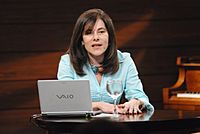Mayana Zatz facts for kids
Quick facts for kids
Mayana Zatz
|
|
|---|---|
| מאיינה זץ | |

Zatz in 2007
|
|
| Born | 16 July 1947 |
| Nationality | Brazilian |
| Alma mater | University of São Paulo |
| Awards | National Order of Scientific Merit (2000) L'Oréal-UNESCO For Women in Science Awards (2001) Premio México de Ciencia y Tecnología (2008) |
| Scientific career | |
| Fields | Biochemistry, molecular biology, genetics |
| Doctoral advisor | Oswaldo Frota-Pessoa |
Mayana Zatz (born July 16, 1947) is a famous Brazilian scientist. She is a molecular biologist and a geneticist. This means she studies how living things work at a tiny level and how traits are passed down through families. She is a professor at the University of São Paulo. She also helps lead research at the university as its Research Dean.
Contents
About Mayana Zatz
Mayana Zatz has received many important awards for her work. These include the 2000 L'Oréal-UNESCO For Women in Science Awards. This award celebrates women who have made amazing discoveries in science. She also won the Woman of the Year Award from Claudia Magazine in 2001.
Early Life and Education
Mayana Zatz was born in Israel in 1947. When she was young, her family moved to France. They lived there until she was seven years old. In 1955, her family moved to Brazil, where she grew up.
Mayana studied Biology at the University of São Paulo. She earned her first degree in 1968. She continued her studies there, getting her master's and doctorate degrees in Biological Sciences. Later, she did more advanced research in Medical Genetics at the University of California at Los Angeles (UCLA) in 1977.
Helping Families with Genetic Diseases
Mayana became very interested in studying muscular dystrophy during college. This is a group of diseases that cause muscles to weaken over time. She met a patient whose family had many members with this condition. This patient wanted to start a family, which made Mayana think about how to help.
In 1969, Dr. Zatz began helping families who carried genes for neuromuscular diseases. She would explain the risks of having children with these problems. Twelve years later, she checked in with these families again. She found that many high-risk families had decided not to have children.
However, Mayana was sad to see that children born with these conditions were often not getting help. These children usually had normal minds but their muscles were weak. They often did not go to school or get physical therapy to help them.
Founding ABIM
Because of this, Mayana and her team started the Brazilian Association of Muscular Dystrophy (ABIM) in 1981. This organization helps people with muscular dystrophy. Seven years later, ABIM got its own building.
ABIM was the first center in Latin America to help people with dystrophy. It helps about 100 children and teenagers every week. They come in daily groups of twenty patients. The center also has other visits, helping around 300 people each month.
Since it started, ABIM has helped over 1,000 children, many of whom are from poor families. Children are first checked for the illness. If they have it, they get help from the association for their whole lives. ABIM offers physical therapy, hydrotherapy (water therapy), and fun activities. They also have activities that help with creativity and thinking. Both patients and their families can get psychological support.
Research and Discoveries
Mayana Zatz is a member of important science groups. These include the International Human Genome Project and the Brazilian Academy of Sciences. Her research has been mentioned many times in scientific papers.
She has published many articles in well-known science magazines. These include "Nature Genetics" and "Human Molecular Genetics". Mayana also writes a column for the Brazilian Veja Magazine. She received the 2003 TWAS Prize for her scientific work.
Throughout her career, Mayana has helped about 16,000 people from families with genetic diseases. Most of these were neuromuscular problems. This is the highest number of cases recorded anywhere in the world.
In 1995, Mayana, Professor Maria Rita Passos-Bueno, and student Eloísa de Sá Moreira made a big discovery. They were the first scientists to find one of the genes linked to a type of dystrophy that affects the arms and legs. They also found the gene responsible for Knobloch syndrome. This syndrome causes a type of progressive blindness.
See also
 In Spanish: Mayana Zatz para niños
In Spanish: Mayana Zatz para niños

